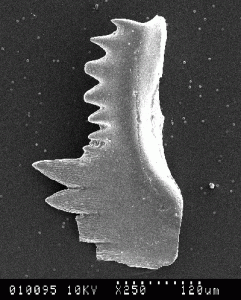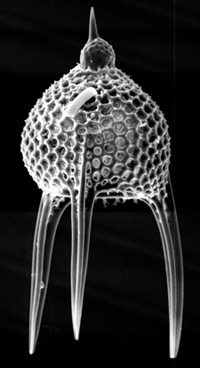Microfossils

The teeth of a lamprey-like conodont. The image is 250X life size, the scale bar equals 120 microns.
Micropaleontology formed a strong aspect of geological research in the early Bureau of Economic Geology (BEG) and the Department of Geological Sciences (DGS). This research provided the collections with a wealth of material especially foraminifera and conodonts.
Current diatom research by Edward Theriot and his lab increase collections within that area in the university.
Conodonts
Most of our conodont collection results from the work of Helen Plummer and later Samuel Ellison. Plummer was particularly involved in examining the Paleozoic rocks of North Central Texas.
Diatoms
A small teaching collection of diatoms is held in this repository but a significant collection of recent and fossil freshwater diatoms is held at College of Natural Sciences in the collection of Edward Theriot.
Foraminifera

Radiolarian
The bulk of these samples derive from the early biostratigraphic collections of the BEG and later research of Martin Lagoe and the students in his lab. There is a large and useful collection of identified taxa.
Ostracods
A small collection of ostracods includes several type and figured specimens.
Other Microfossils
These include a small teaching collection of radiolarians, and calcareous nannofossils (including coccoliths). The microfossil collection includes mounted specimens as well as picked splits and samples of the source rocks for those splits.

